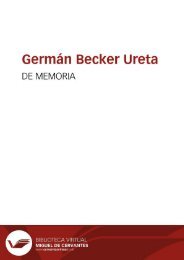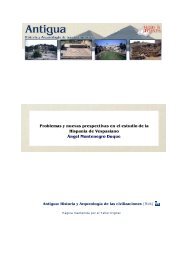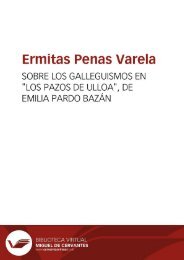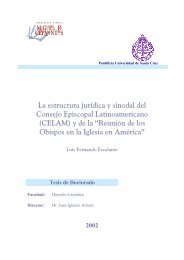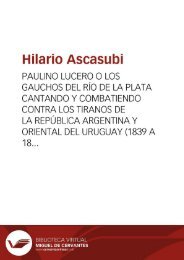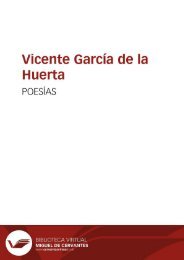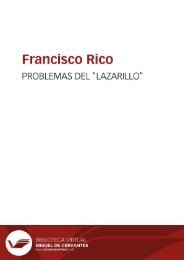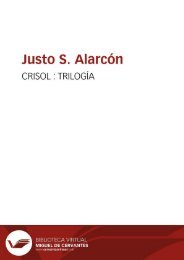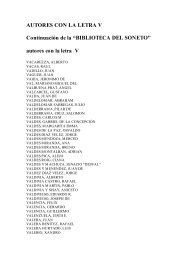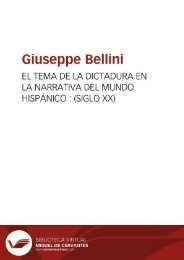You also want an ePaper? Increase the reach of your titles
YUMPU automatically turns print PDFs into web optimized ePapers that Google loves.
Anales galdosianos [Publicaciones periódicas]. Año XII, 1977<br />
likewise change before reaching their final form. In the manuscript « Sus ojos, que habían sido<br />
grandes y hermosos, conservaban todavía un chispazo azul [en medio de su atroz desfiguración y<br />
decadencia], como el fuego fatuo bailando sobre el osario » (ms. p. 79; OC p. 999 b ). The use of<br />
the fuego fatuo simile emphasizes the life and intelligence that are still Encarnación's most important<br />
characteristics, rather than a decadence that would destroy her further usefulness to the author. Further<br />
descriptions of her are also softened in the final version; in the manuscript her arms are covered by<br />
« un pellejo [flácidol [flojo] » (ms. p. 80), while in the corrected version and printed text it is a «<br />
pellejo sobrante » (ms. p. 80; OC p. 1000 a ) that covers them. Her fingers begin by being stuck<br />
on with saliva: « las falanges [parecían pegadas con saliva] » (ms. p. 80) while in the final and<br />
printed versions they are « tan ágiles que parecían sueltas » (ms. p. 80; OC p. 1000 a ). Most<br />
insulting of all, in the manuscript <strong>Galdós</strong> actually describes her as a member of the Rufete family<br />
(the Canónigo's aunt):<br />
y más charlatana que todos los cómicos de Madrid.<br />
[Pero no me has dicho nada, cachas!, qué puñales! Y mi sobrino tu tío el Canónigo?<br />
Isidora no omitió nada que pudiese (illegible) habló largo rato de su tío el Canónigo, acomodado<br />
vecino del Tomelloso, de cuya prolija relación recibió no poca molestia la Sanguijuelera, porque todo<br />
lo que hablaban los demás le parecía un ataque a su incontestable derecho de usar de la palabra.]<br />
(ms. p. 78; OC p. 999b) 45<br />
Later she is depicted as half-demented, a state befitting a Rufete, in a fragment of the primitive<br />
manuscript which was intended to end Chapter III. Isidora has just escaped from the children who<br />
have followed her away from her great-aunt's house:<br />
La Sanguijuelera se metió en su tienda, corrió al patio, volvió, fue, vino, dio varias vueltas, como<br />
un avechucho enjaulado, y después de hablar sola con febriles movimientos, cogió con ambas manos<br />
el delantal azul que de su cintura pendía, se lo llevó a los ojos, apretó fuerte, lanzó un gran berrido, y<br />
de sus ojos, de todos los orificios de su cara brotó un raudal. ¡Qué modo de llorar!<br />
(primitive ms. p. 114, back of ms. p. 121) 46<br />
45 For two different opinions of Encarnación's relation to the Rufete family, see Rodgers<br />
(loc. cit.) and Robert H. Russell, «The Structure of La desheredada », MLN , LXXVI,<br />
numbers 6-8 (December 1961), pp. 794-800.<br />
46 <strong>Galdós</strong>, as is known, crossed out pages which did not satisfy him and often used<br />
the reverse side (after blue-pencilling the first version) to write the final version of the<br />
manuscript. Thus in La desheredada , as in many other manuscripts, we have the<br />
34



